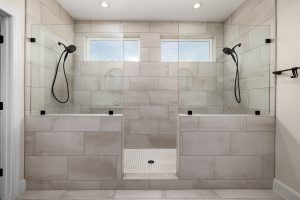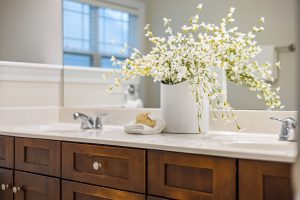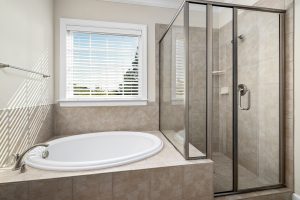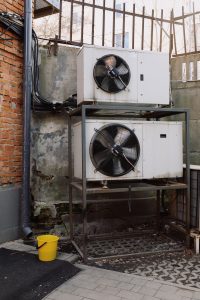
Are you worried about the Ventilation for a small powder room and airflow in your tiny space? Lack of fresh air when freshening up can be a bother. Therefore, when customizing your Ventilation for a small powder room,s you need to consider many factors to make it comfortable and habitable.
Proper Ventilation ensures air circulation, preventing moisture and odor buildup. It also provides a refreshing, clean, and pleasant powder room. Thermaintainingtain a comfortable and healthy environment. Assess the existing Ventilation to evaluate the current situation. Here are some suggestions to customize Ventilation for small powder rooms
How to customize Ventilation for small powder rooms

When customizing the ventilation for your tiny powder room can help improve air circulation and prevent issues such as humidity buildup and odors that can be unpleasant. Here are some steps to consider:
Take the correct measurement for the room
When customizing your room, you need to ensure that you take the correct measurements of the dimensions of your powder room to determine the appropriate fan size or ventilation requirements. It will help you choose the right equipment for efficient airflow.
Calculate the room size and Ventilation requirements: Measure the dimensions of the powder room to determine its square footage. Having at least one cubic foot per minute (CFM) of Ventilation per square foot of the space is generally recommended. Multiply the square footage by the recommended CFM value to estimate the required airflow.
Install Exhaust Fan
If your powder room doesn’t already have an exhaust fan, consider Installing an exhaust fan specifically designed for small spaces. It’s the most common and effective way of Ventilation. The fan should have adequate power to remove odors, moisture, and stale air from the room.
Place the source of odors or moisture, such as above the toilet, the ceiling, or the shower, to help remove odors. Choose a fan with appropriate airflow capacity for the size of your room.
Choose a fan with a CFM rating suitable for the room size. Look for a model designed specifically for small spaces. Position the exhaust fan near the source of odors, such as the toilet or vanity, to effectively remove unpleasant smells.
Ventilation Ducts Works
Connect the exhaust fan to ventilation ducts to channel the air outside. Ensure that you insulate the ducts properly and sealed to prevent air leakage. If your powder room is far from an exterior wall, you may need flexible ducts to navigate through the ceiling or walls to reach the external vent.
Use rigid metal or flexible ducts designed for ventilation purposes. Ensure you seal the ductwork adequately to prevent air leaks. Avoid long, convoluted duct runs, as they can reduce the efficiency of the ventilation system.
Add a Timer or Humidity Motion Sensor
Add a timer or motion sensor to the exhaust fan. It allows the fan to turn on and off automatically based on a preset duration or when someone enters the room. These features help ensure the fan operates well when needed and saves energy when not in use.
You may opt for an exhaust fan with built-in features such as a timer or humidity sensor to enhance efficiency and reduce energy consumption. A timer allows you to set the fan to operate for a specific duration, while a humidity sensor automatically activates the fan when moisture levels rise above a certain threshold.
Supplement with Natural Ventilation
IIncorporateilation by adding a window or vent to the powder room. It can help improve air circulation and provide an additional means for odor dissipating. Ensure the window or vent is appropriately sealed to prevent drafts.
Consider installing a transom if your powder room has an exterior wall; a window can enhance Ventilation and bring natural light. If a window is not an option, consider adding a transom window above the Door or incorporating a glass block panel in an interior wall to allow light and air circulation.
Air Purifiers
Consider using small air purifiers designed for compact spaces for additional air quality improvement. Using an air purifier in your small powder root can help improve air quality by removing pollutants, dust, allergens, and odors.
Consider the types of filters used in the air purifier. Common filter options are
- HEPA Filters: High-Efficiency Particulate Air (HEPA) filters effectively remove tiny particles, such as dust, pollen, pet dander, and some airborne bacteria. They are highly recommended for allergy sufferers.
- Activated Carbon Filters: Activated carbon filter eliminates odors, smoke, and chemical fumes. They can help reduce unwanted smells in the powder room.
- Pre-Filters: Pre-filters capture larger particles like dust and hair, extending the lifespan of the primary filters and improving overall efficiency.
Some air purifiers have additional features that benefit a small powder room. Examples include:
- Automatic Sensors: Air purifiers with sensors can detect air quality and adjust the fan speed accordingly. It can help optimize performance and energy efficiency.
- Timer Function: A timer allows you to set the air purifier to operate for a specific duration, helping to conserve energy.
- Filter Replacement Indicators: Look for models with indicators to remind you when to replace the filters. Regular filter replacements ensure optimal performance.
Proper and Regular Maintenance
Regularly clean the exhaust fan and ventilation system for optimal performance. Clean the vents, windows, and exhaust fans regularly. Remove any dust or debris accumulating in the fan or ducts, hindering airflow and reducing efficiency.
Regular maintenance also ensures optimal performance cleaning and regularly check for faulty exhaust fan and ducts, remove any accumulated dust or debris, and replace them if need be. Additionally, replace the fan’s filters or screens as needed.
Choose a vented light fixture.
Upgrade your ceiling to a vented model with a built-in fan. It will help provide lighting and Ventilation in one unit, maximizing space efficiency.
Keeping the Door open
Open the powder room door when there is no airflow to enable fresh, natural airflow to allow new, natural airflow. It will allow air to circulate from adjacent areas preventing the room from being stuffy or humid. It is the best option as it is free and readily available.
Consult a Professional Technician
Suppose you are still trying to determine the best ventilation options for your tiny powder room and need further clarification. Consulting a professional, such as a contractor or HVAC technician, is advisable. In that case, They can assess your requirements and recommend the most suitable ventilation system.
Ventilation requirements can vary depending on the size and layout of your powder room, local building codes, and other factors. When choosing the ventilation options that best meet your needs, you are considering these factors.
Importance of Ventilation for a small powder room
Ventilation is crucial for a small powder room for several important reasons: Here are some essential reasons.
Removal of odors
A powder room is often used for quick visits and can accumulate unpleasant odors. Proper Ventilation helps remove these odors, ensuring a fresh and inviting atmosphere for guests and household members.
Moisture control
Bathrooms, including powder rooms, generate significant moisture from showering, handwashing, and flushing. This moisture can accumulate on surfaces without adequate Ventilation, leading to mold and mildew growth. Ventilation helps expel excess water, preventing the growth of harmful microorganisms and protecting the room’s integrity.
Air quality improvement
A poorly ventilated powder room can have stagnant air that contains various pollutants, like volatile organic compounds (VOCs) from cleaning products or aerosols. Proper Ventilation helps remove these pollutants, maintaining better indoor air quality and reducing the potential for respiratory issues and allergic reactions.
Heat and humidity reduction
Ventilation removes excess heat and humidity from the powder room. It is essential in small spaces, as they heat up quickly. Ventilation helps create a more comfortable environment by preventing the room from becoming excessively hot and humid.
Prevention of structural damage
Excessive moisture and humidity may cause long-term damage to the structure of the powder room, including walls, ceilings, and fixtures. Ventilation helps prevent condensation and moisture buildup, reducing the risk of paint peeling, wallpaper damage, and deterioration of materials over time.
Proper Ventilation in a small powder room is vital for maintaining a clean, healthy, and comfortable environment. It ensures the removal of odors, controls moisture levels, improves air quality, prevents structural damage, and enhances the general experience for users of the space to peak efficiency.
How to enhance Ventilation for a small powder room
To improve Ventilation in a small powder room, consider the following options to give your room a pleasant fresh smell.
Install an exhaust fan.
The most effective way to improve Ventilation is by installing an exhaust fan. Choose a fan with sufficient airflow capacity for the size of your powder room. Install it near the ceiling or above the toilet to remove moisture, odors, and steam. Ensure the fan is vented to the outdoors, not just the attic.
Openable window
If your powder room has a window, ensure you can open it easily. Opening the window allows fresh air to circulate and helps remove odors. Consider installing a window fan to help pull air out of the room when the window is open.
Use a vented light fixture.
If your powder room has a ceiling light fixture, consider replacing it with a vented model with a built-in fan. It combines lighting and Ventilation in one unit, making it an efficient space-saving solution.
Transom window or glass block
If your powder room has no exterior wall or window, you can create a transom window above the Door or incorporate a glass block panel in an interior wall. These options allow natural light to enter and aid in air circulation.
Keep the Door open
Leaving the Door open while using the powder room can help improve airflow. It circulates air from adjacent rooms, reducing moisture buildup and odor retention.
Use a dehumidifier
If excess humidity is a persistent problem, especially in humid climates, consider using a small dehumidifier in the powder room. This device will help remove moisture from the air, preventing mold and mildew growth.
Regular cleaning and maintenance
Ensure the ventilation system, whether an exhaust fan or window, is regularly cleaned and maintained. Dust and debris can accumulate, reducing their effectiveness.
Remember, proper Ventilation is crucial for maintaining a healthy and comfortable environment in your powder room. Consider combining these options to improve the air quality and keep the space fresh. Read more about powder room accessories here bathroomflair.com/bathroom-accessories-for-bathrooms-under-100-sq-feet/
How to Maximize Ventilation for Small Powder Rooms
To maximize Ventilation in a small powder room, follow these tips.
Install a High-Quality Exhaust Fan
Choose an exhaust fan designed for small spaces with a high extraction rate. To ensure efficient airflow, look for a fan with a higher cubic foot per minute (CFM) rating.
Optimize Fan Placement
Position the exhaust fan strategically to remove moisture, odors, and stale air. Placing the fan near the water source, such as above the toilet or the shower, is ideal. Ensure that any objects or furniture do not obstruct the fan.
Use a Ventilation Duct
Connect the exhaust fan to a ventilation duct to direct the extracted air outside. Ensure the vent is insulated and sealed to prevent air leakage and condensation. The shorter and straighter the duct run, the better the airflow.
Use a Grille or Vent Cover
Install a grille or vent cover on the exterior wall or ceiling where the ventilation duct terminates. It prevents insects, debris, and weather elements from entering, allowing the expelled air to escape freely.
Consider a Passive Inlet
Consider installing a passive inlet such as a vent or a small opening in an exterior wall or Door to enhance airflow. It allows fresh air to enter the powder room, creating natural circulation and preventing the room from becoming too pressurized.
Remove Obstructions
Ensure that objects like towels, clothes, or furniture do not obstruct the vents, air registers, and exhaust fans. Clearing these obstructions allows air to flow freely and maximizes Ventilation.
Open Windows and Doors: If your powder room has a window or a nearby door, open them to allow cross ventilation. It can help exchange stale air with fresh air from outside, especially during pleasant weather.
Consider Additional Fans
Use ceiling or portable fans in the powder room if possible. These fans can help improve air circulation and create a comfortable environment.
Regular Cleaning and Maintenance
Keep the exhaust fan and ventilation system clean and well-maintained. Clean or replace the fan filter regularly to prevent dust and debris buildup, which can hinder proper airflow.
Control Humidity Levels: Use an effective ventilation system to minimize excess moisture and promptly address leaks or plumbing issues. Use a dehumidifier if necessary, especially in areas with high humidity.
Implementing these strategies maximizes Ventilation and maintains a fresh, comfortable environment in your small powder room.
How to optimize Ventilation for a small powder room
Optimizing Ventilation in a small powder room is essential to maintain good air quality and prevent moisture buildup. Here are some tips to help you maximize Ventilation in a small powder room.
Install an Exhaust Fan
An exhaust fan is one of the most effective ways to improve Ventilation in a powder room. It helps remove odors, moisture, and pollutants from the air. Select a suitably sized exhaust fan based on the room’s square footage. Ideally, choose a fan with a higher CFM (cubic feet per minute) rating to ensure efficient air extraction.
Position the Exhaust Fan Correctly
Install the exhaust fan near the source of moisture and odors, usually above or near the toilet. This placement allows the fan to draw out the air efficiently, reducing the risk of condensation and mold growth. Ensure that the exhaust duct is connected correctly and vented to the outside of the building to prevent air recirculation.
Use a Timer or Humidity Sensor
To ensure adequate Ventilation and prevent excessive energy consumption, consider installing a timer or humidity sensor for the exhaust fan. A timer allows you to set the fan to operate for a specific duration, while a humidity sensor automatically activates the fan when it detects increased humidity levels.
Provide Adequate Airflow
Ensure the powder room has proper air circulation by allowing air to enter and exit the space. Provide a gap beneath the Door or install a louvered door to allow air to flow freely. If possible, position the supply air vent (if present) away from the exhaust fan to prevent the drawn-out air from being immediately replaced with conditioned air.
Consider Transom Windows or Vents
Include Transom windows or vents in the powder room design if feasible. These features allow natural Ventilation by enabling fresh air to enter while letting stale air escape. They can enhance airflow without compromising privacy.
Keep the Door Open
When the powder room is not in use, keeping the Door open can facilitate better air circulation. This practice allows air from adjacent spaces to flow into the room, reducing stagnant air and aiding Ventilation.
Regular Maintenance
Ensure that the exhaust fan is maintained correctly. Clean the fan and its components regularly to prevent dust and debris buildup, which can hinder performance. Replace the fan’s filter or grille if applicable.
By implementing these ventilation strategies, you can improve airflow and maintain a fresh and comfortable environment in your small powder room.
How to create better Ventilation for small powder rooms
Having better Ventilation improves air quality and comfort. It gives your powder room a pleasant fresh smell. Here are some tips to help you achieve better Ventilation.
Install an Exhaust Fan
An exhaust fan is essential for proper Ventilation in a powder room. Choose a fan with adequate power and CFM (cubic feet per minute) rating suitable for small spaces. Install the fan near the source of moisture or odors, such as above the toilet or the shower.
Optimize Fan Placement
Proper exhaust fan placement is crucial for adequate Ventilation. Ensure it is positioned to capture and extract air pollutants efficiently. Install the fan close to the ceiling to remove rising warm air.
Ventilation Ducts
Connect the exhaust fan to ventilation ducts to channel the extracted air outside. Insulate and seal the ducts properly to prevent air leakage. If the powder room is far from an exterior wall, consider using flexible ducts to navigate through the ceiling or walls to reach an external vent.
Use an Adjustable Timer or Motion Sensor
Install an adjustable timer or motion sensor switch for the exhaust fan. It ensures that the fan operates for a specific duration or automatically turns on when someone enters the room. It helps maintain proper air circulation and reduces energy consumption.
Consider a Window or Transom
Include a window or transom above the Door in your powder room. These provide natural Ventilation by allowing fresh air and stale air to exit. Ensure you can open the window and secure the screen for insect protection.
Door Undercut or Transfer Grille
To allow air circulation even when the Door is closed, consider creating a slight undercut at the bottom or installing a transfer grille. These openings allow air between the powder room and adjacent spaces, ensuring better Ventilation.
Use Passive Inlets
Install passive air inlets in exterior walls or doors, such as vents or grilles. These allow fresh air to enter the powder room and improve air circulation. Place the in-lets strategically to promote cross-ventilation.
Regular Cleaning and Maintenance
Keep the exhaust fan and ventilation system clean and well-maintained. Clean or replace the fan filter regularly to prevent blockages and maintain optimal airflow.
Minimize Moisture Sources
Control moisture levels by promptly addressing leaks or plumbing issues. Use bath mats and towels to absorb excess moisture and prevent it from accumulating in the air. Ensure the powder room is adequately ventilated after hot showers or baths.
Consider Air Purifiers
If your powder room still experiences air quality issues, consider using a small air purifier designed for compact spaces. These devices can help remove dust, allergens, and other pollutants from the air, further enhancing Ventilation.
Remember, ventilation requirements can vary depending on room size, local building codes, and specific needs. It’s advisable to consult with a professional, such as a contractor or HVAC technician, to ensure the ventilation improvements are suitable for your tiny powder room.
Conclusion
Proper Ventilation is crucial for small powder rooms to maintain clean, comfortable, and healthy Ventilation. You can address common issues such as odors, moisture buildup, air quality, and heat control. Installing an exhaust fan, utilizing or transforming windows, keeping the Door open, and considering a dehumidifier are all valuable strategies to enhance Ventilation.
A well-ventilated powder room improves the overall experience for quests and household members and helps prevent structural damage caused by excessive moisture. Regular cleaning and maintenance of the ventilation system are essential to ensure its efficiency and longevity.
Remember, each powder room is unique, and customization may be necessary based on your space’s specific layout and needs. Seeking professional assistance can provide valuable insights and guidance. If you prioritize your Ventilation and implement the appropriate measures, you can create a small powder room that is fresh, comfortable, and inviting for everyone who uses it.





0 Comments